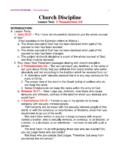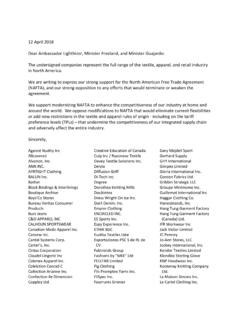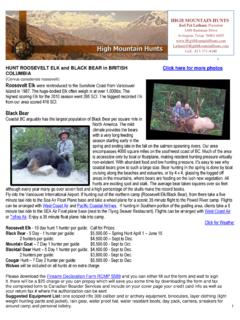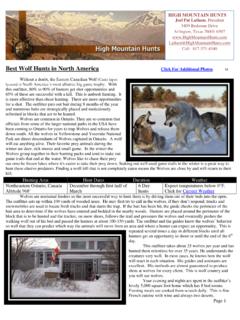Transcription of We are huge believers in raw foods for our cats and …
1 We are huge believers in raw foods for our cats and dogs. Why? There is no diet that is more natural, more species appropriate than raw. What does that mean? Simply put, dogs and cats are carnivores, eaters of raw meat (dogs are, technically, scavengers/carnivores, cats are obligate carnivores). They do not eat corn; wheat is not a part of a wild dog's diet. A wild canine's ingestion of veggies, fruits, and grains is going to be minimal. There is no company processing all the game and prey into convenient little dry kibbles for the wild dogs, wolves, coyotes, and dingoes.
2 To give our pets the best chance at great health, we need to provide a diet as close as possible to what they are genetically evolved to eat. Why raw? Processed kibble has been ground, cooked, and extruded. A lot of the natural vitamins, minerals, and enzymes are destroyed to make a product that is convenient and easy to feed. Raw food is minimally processed, so it retains the micronutrients that fresh meat has. Feeding your dog or cat a raw diet can lead to: Firmer stools Improved digestion Healthier skin and coat Reduced allergy symptoms Reduced risk of cancer and diabetes Improved oral health Better weight management We've seen older dogs that have slowed down start to act like puppies again.
3 Raw foods also act like our sugar-free gum; their tongue moves a lot more to eat the food, spreading saliva, like we do when we chew gum, loaded with enzymes and helps keep their teeth and gums healthy. Transitioning to a raw diet The most important thing to keep in mind when transitioning from dry kibble to a raw diet is to go slow. Raw diets are much richer then the kibble they are used to eating, and quickly changing foods can cause stomach problems, making the transition more difficult and less likely to succeed. Offer a small bite as a treat between meals, keeping an eye on their stools.
4 Over the next few days, increase the number of new food treats. If their stools stay normal, you can then replace one of their meals with a little of the raw. If at any time their stool is too loose, decrease the raw and go longer before increasing the amounts again. How to feed raw foods Raw meats need to be defrosted in the fridge, not on the counter (this goes for our foods , too.). Place enough food for three days in a container in the fridge; begin feeding the next day. When you have one day's worth of food left, set another three days worth of food in another container and place it in the fridge to defrost for the next time.
5 Raw diets can be offered as the sole diet, or can be alternated with dry kibble; many people offer the raw in the evening and keep kibble down during the day. It is not suggested to mix both raw and dried, as the different forms may cause some stomach upset with gas and bloating. Safety There are a lot of concerns and myths that raw meat diets are dangerous from bacteria like e. coli and salmonella. This is raw meat, so some common sense rules need to be followed, again, no differently than when handling meat for our dinner, mainly washing all containers, surfaces, and utensils thoroughly.
6 Prevent cross contamination by washing your hands well. It does need to be noted, however, there have been far fewer recalls of raw diets compared to kibble for bacterial contamination in the last several years. A dog and cat's digestive system is vastly different than ours, and that makes it very difficult for them to suffer from food-borne pathogens (even if they were present in the food). Their mouths are loaded with enzymes whose sole purpose is to help destroy pathogens as they pass while eating. Their stomachs are made to handle high bacteria loads; their food stay in their stomach, in an acid bath, for 8 hours, with a quick trip, of only a couple of hours, through their intestines.
7 This naturally evolved defense against pathogens keeps them healthy. Controversy about raw. There is a huge dispute concerning raw diets for cats and dogs. The American Veterinarian Medical Association, after the annual meeting every year, comes out with a statement against raw diets. Many vets do not like raw diets. We think this comes from a lack of knowledge of raw diets, and a tendency to get stuck doing things the way we always have. Some people have rushed to the vet for diarrhea after switching to a raw diet. The vets, naturally, blame the raw meat without getting more info, like how long the transition to raw food was.
8 Wholistic vets do believe in raw diets and are, fortunately, a growing voice supporting these more natural diets. They have seen the amazing changes a biologically appropriate diet can bring about in an older dog, how it can preserve a dog's health, and understand how to properly feed a raw diet. We have witnessed many dogs and cats that benefit from a whole, uncooked diet. Owners who have tried every cooked kibble on the market with little success have, as a last resort , have switched their pet with health problems to a raw diet (we think this should have been the first option).
9 The improvements in skin ailments, obesity, digestive problems, and diabetes have been remarkable. See what well known wholistic vets Dr Karen Becker and Dr Barbara Royal have to say about raw diets: 20120829_1_pet-owners-royal-treatment-mo onshine Dr Royal's book, "The Royal Treatment: A Natural Approach to Wildly Healthy Pets", has a lot more info on raw diets. We always suggest talking to your vet about your pet and their health; taking along some information you've gained from your research can help you make the right decision. And, as always, stop by and talk to any of our knowledgeable staff about the best diets for your cat or dog!








